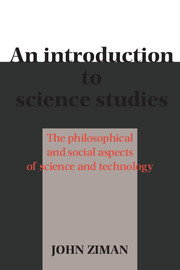Book contents
- Frontmatter
- Contents
- Preface
- 1 ‘Academic’ science
- 2 Research
- 3 Validity
- 4 Communication
- 5 Authority
- 6 Rules and norms
- 7 Change
- 8 The sociology of scientific knowledge
- 9 Science and technology
- 10 Pure and applied science
- 11 Collectivized science
- 12 R & D organizations
- 13 The economics of research
- 14 Science and the State
- 15 The scientist in society
- 16 Science as a cultural resource
- Index
10 - Pure and applied science
Published online by Cambridge University Press: 05 August 2012
- Frontmatter
- Contents
- Preface
- 1 ‘Academic’ science
- 2 Research
- 3 Validity
- 4 Communication
- 5 Authority
- 6 Rules and norms
- 7 Change
- 8 The sociology of scientific knowledge
- 9 Science and technology
- 10 Pure and applied science
- 11 Collectivized science
- 12 R & D organizations
- 13 The economics of research
- 14 Science and the State
- 15 The scientist in society
- 16 Science as a cultural resource
- Index
Summary
‘The constant activity which you Venetians display in your famous Arsenal suggests to the studious mind a large field for investigation.’
Galileo Galilei‘R & D’ in ‘S & T’
Science and Technology – perhaps one should say, ‘the sciences and their associated technologies’ – together constitute a major social institution based upon the systematic generation, accumulation and utilization of knowledge. This knowledge is very diverse. Some of it is directly useful; some of it appears totally divorced from human affairs. Some of it is symbolically codified in the form of experimental data, theoretical formulae, solutions to standard problems, therapeutic protocols and engineering blueprints: some of it is essentially tacit, and only becomes manifest through expert technical work (§15.4). Much of the knowledge that is put to use has simply accumulated in the scientific and technical archives, over a period of many years. As in the past, a considerable amount of formal technological knowledge is continually being produced in day-to-day practice; in clinical medicine, for example, any novel course of treatment may be considered something of an experiment.
The immense social dynamism of modern ‘S & T’ comes from its aggressive employment of the social device of research – that is to say, systematic activity undertaken to obtain information or understanding that goes beyond established knowledge or accepted practice.
- Type
- Chapter
- Information
- An Introduction to Science StudiesThe Philosophical and Social Aspects of Science and Technology, pp. 121 - 131Publisher: Cambridge University PressPrint publication year: 1984



